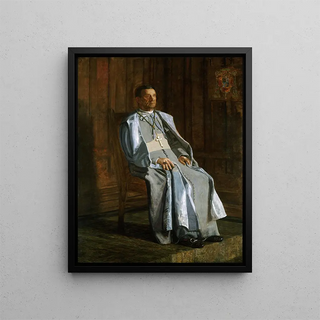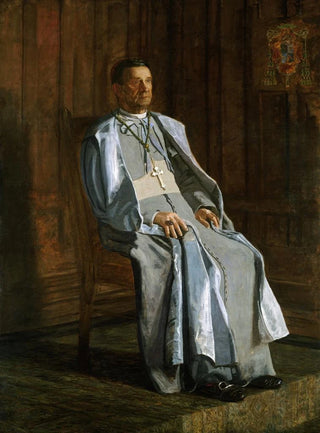Art print | Archbishop Diomède Falconio - Thomas Eakins


View from behind

Frame (optional)
Thomas Eakins' "Archbishop Diomède Falconio" art print presents itself as an open window into a time when art and spirituality intertwined intimately. This painting, which captures the essence of a Catholic Church prelate, goes beyond depicting a man in ecclesiastical attire; it also evokes the weight of tradition and the depth of faith. By immersing ourselves in this work, we are invited to explore Falconio's complex personality while discovering Eakins' unparalleled talent for immortalizing historical figures with almost photographic precision. The light, colors, and textures come together to create an atmosphere imbued with solemnity, transporting us to a world where every detail matters.
Style and uniqueness of the art print
Thomas Eakins' style is distinguished by its striking realism and his ability to capture the psychology of his subjects. In "Archbishop Diomède Falconio," he employs painting techniques that reveal not only the physical stature of the archbishop but also his character. The choice of colors, ranging from dark tones to brighter shades, creates a contrast that draws our attention to the prelate's face, where every wrinkle and expression tells a story. The composition of the art print, with a simple background that highlights the subject, demonstrates Eakins' skill in directing the viewer's focus. This piece is not merely a simple representation; it is an exploration of humanity, faith, and dignity.
The artist and his influence
Thomas Eakins, an emblematic figure of 19th-century American art, knew how to leave his mark on his era through his innovative approach and commitment to realism. Trained in Paris, he managed to incorporate European influences while developing a style unique to American culture. Eakins was always fascinated by human representation, whether through portraits, scenes of daily life, or even anatomical studies. His work had a significant impact on his contemporaries and on subsequent generations of artists, who were inspired by his attention to detail and his ability to capture

Matte finish

View from behind

Frame (optional)
Thomas Eakins' "Archbishop Diomède Falconio" art print presents itself as an open window into a time when art and spirituality intertwined intimately. This painting, which captures the essence of a Catholic Church prelate, goes beyond depicting a man in ecclesiastical attire; it also evokes the weight of tradition and the depth of faith. By immersing ourselves in this work, we are invited to explore Falconio's complex personality while discovering Eakins' unparalleled talent for immortalizing historical figures with almost photographic precision. The light, colors, and textures come together to create an atmosphere imbued with solemnity, transporting us to a world where every detail matters.
Style and uniqueness of the art print
Thomas Eakins' style is distinguished by its striking realism and his ability to capture the psychology of his subjects. In "Archbishop Diomède Falconio," he employs painting techniques that reveal not only the physical stature of the archbishop but also his character. The choice of colors, ranging from dark tones to brighter shades, creates a contrast that draws our attention to the prelate's face, where every wrinkle and expression tells a story. The composition of the art print, with a simple background that highlights the subject, demonstrates Eakins' skill in directing the viewer's focus. This piece is not merely a simple representation; it is an exploration of humanity, faith, and dignity.
The artist and his influence
Thomas Eakins, an emblematic figure of 19th-century American art, knew how to leave his mark on his era through his innovative approach and commitment to realism. Trained in Paris, he managed to incorporate European influences while developing a style unique to American culture. Eakins was always fascinated by human representation, whether through portraits, scenes of daily life, or even anatomical studies. His work had a significant impact on his contemporaries and on subsequent generations of artists, who were inspired by his attention to detail and his ability to capture






